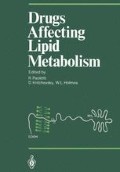Abstract
Despite their relevant physiological and structural role, phospholipids (PL) have not gained favour in clinical assessment of human atherosclerosis. Already in 1951, Gertler et al. recorded higher values of serum lipid phosphorus in coronary patients than in controls. Furthermore, it was shown that the serum cholesterol/lipid phosphorus is increased in the presence of coronary heart disease (CHD). The same authors suggested a “chemotype” which included the analysis of serum cholesterol, phospholipids and uric acid. A recommandation was also given to increase the values of plasma PL, thus reestablishing a normal C/PL ratio. The meaning of the recorded variations of PL plasma values has not been discussed. An increased C/PL ratio has also been recorded in type II hyperlipoproteinaemia (Peeters 1976). Increased values of ratio sphyngomye-lin/phosphatidylcholine (SM/PC) was observed in types II and IIB, being normal in type IV (Peeters 1976). The lecithin/sphyngomyelin ratio is abnormally low in homozygotes with familial xanthomatosis hypercholesterolaemia (FXH) (Mills et al. 1976). In the low density lipoproteins (LDL) of FXH, an increased C/PL ratio was recorded with a decreased lecithin/sphyngomyelin ratio (Jadhav and Thompson 1979). Since this abnormal composition of LD1 normalizes following plasma exchange it has been suggested that the abnormal composition of LDL in FHX is due to hypocatabolism and then to the aging of LDL (Jashav and Thompson 1979). The chemical percentage composition of the major lipoprotein classes has been studied in survivors of myocardial infarction (Avogaro et al. 1979).
Access this chapter
Tax calculation will be finalised at checkout
Purchases are for personal use only
References
Avogaro P (1983) Phospholipids and atherosclerosis. In: Avogaro P, Mancini M, Ricci G, Paoletti R (eds) Phospholipids and atherosclerosis. Raven, New York, pp 211–214
Avogaro P, Cazzolato G, Bittolo Bon G, Belussi F (1979) Levels and chemical composition of HDL HDL and other major lipoprotein classes in survivors of myocardial infarction. Artery 5:495–508
Gertler MM, Garn SM, White PD (1951) Young candidates for coronary heart disease. JAMA 147: 621–624
Goldstein JL, Ho YK, Basu SK, Brown MS (1979) Binding site on macrophages that mediates uptake and degradation of acetylated low density lipoprotein, producing massive cholesterol deposition. Proc Natl Acad Sci USA 76:333–377
Henriksen T, Mahoney E, Steinberg D (1981) Enhanced macrophage degradation of low density lipoprotein previously incubated with cultured endothelial cells: recognition by receptors for acetylated low density lipoproteins. Proc Natl Acad Sci USA 78:6499–6503
Jadhav AV, Thompson GR (1979) Reversible abnormalities of low density lipoprotein composition in familial hypercholesterolaemia. Eur J Clin Invest 9:63–67
Mills GL, Taylaur CE, Chapman MJ (1976) Low density lipoproteins in patients homozygous for familial hyperbetalipoproteinaemia. Clin Sci Mol Med 51:221–231
Parthasarathy S, Steinbrecher VP, Barnett J, Witzum JL, Steinberg D (1985) Essential role of phos-pholipase A2 activity in endothelial cell induced modification of low density lipoprotein. Proc Natl Acad Sci USA 82:3000–3004
Peeters H (1976) The biological significance of the plasma phospholipids. In: Peeters H (ed) Phosphatidylcholine. Springer, Berlin Heidelberg New York, pp 10
Sevanian A, Kim E (1985) Phospholipase A2 dependent release of fatty acids from peroxidized membranes. J Free Rad Biol Med 1:263–271
Smith DL, Willis AL, Mahmud I (1984) Eicosanoid effects on cell proliferation in vitro: relevance to atherosclerosis. Prostagl Leukotrien Med 16:1–10
Steinbrecher UP, Parthasarathy S, Leake DS, Witzum JL, Steinberg D (1984) Modification of low density lipoproteins by endothelial cells involves lipid peroxidation and degradation of low density lipoprotein phospholipids. Proc Natl Acad Sci USA 81:3883–3887
Author information
Authors and Affiliations
Editor information
Editors and Affiliations
Rights and permissions
Copyright information
© 1987 Springer-Verlag Berlin Heidelberg
About this paper
Cite this paper
Avogaro, P., Bon, G.B., Cazzolato, G. (1987). Phospholipids in Human Atherosclerosis. In: Paoletti, R., Kritchevsky, D., Holmes, W.L. (eds) Drugs Affecting Lipid Metabolism. Proceedings in Life Sciences. Springer, Berlin, Heidelberg. https://doi.org/10.1007/978-3-642-71702-4_77
Download citation
DOI: https://doi.org/10.1007/978-3-642-71702-4_77
Publisher Name: Springer, Berlin, Heidelberg
Print ISBN: 978-3-642-71704-8
Online ISBN: 978-3-642-71702-4
eBook Packages: Springer Book Archive

